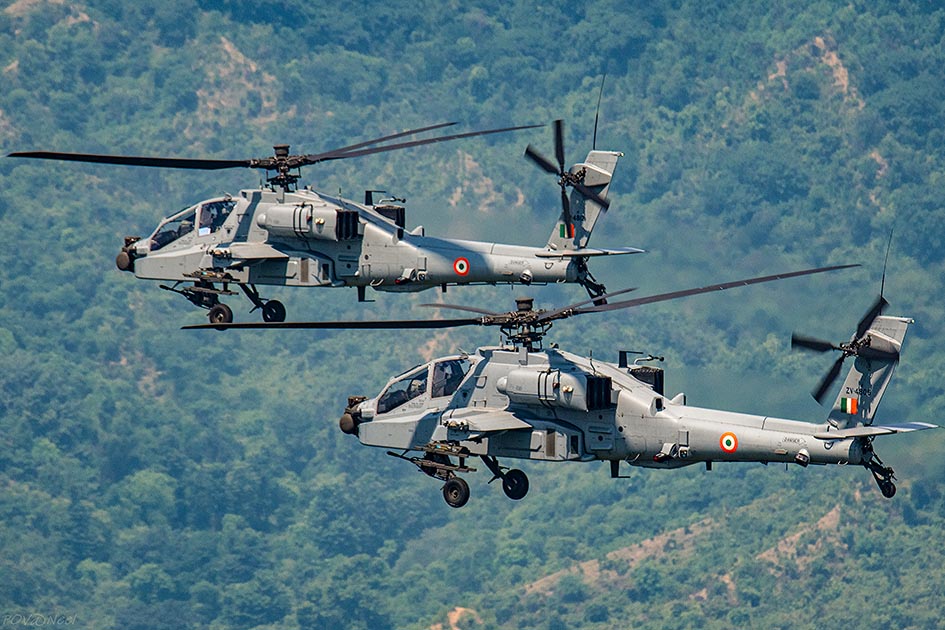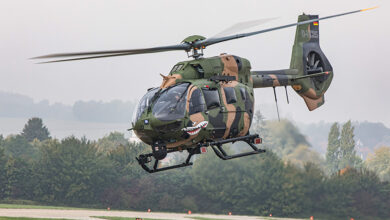By Air Marshal GS Bedi (Retd)
New Delhi. Combat Helicopters play a critical and decisive role in Air to Ground battles, and although both the Indian Air Force and Indian Army are asking for more Boeing Apaches than the already sanctioned strength of 22 and six respectively, the Ministry of Defence is leaning towards the Army for its expanded projection.
There is already some progress, and financial allocations are being worked out for a G-to-G deal with the US under its Foreign Military Sales (FMS) programme.

Induction of Apache Helicopters
Apache helicopters have been welcomed into the Indian Armed Forces as they are a valuable asset to any military force. They provide unrivalled firepower, survivability, mobility, and precision, which makes them a powerful force multiplier that can boost fighting capability significantly. They have proved their worth in various conflicts such as the Gulf wars and Afghanistan. Indian armed forces too stand to gain tremendously from their induction into their fold.
The Indian Air Force has received its full complement of 22 machines, and the Army is scheduled to get their six by the next year. A serious void had been created by the near phasing out of Russian Mi25/35 attack helicopters, which has been amply filled by the induction of this versatile machine. In fact, IAF deployed the Apaches in Ladakh sector during the China Stand-off, and continuously trains for their optimum employment in varied weather and operational scenarios.
Ownership issues
However, apart from the celebration, contentious claims of their rightful ownership between the Indian Air Force and Army have been surfacing in various reports at every opportune moment. Such is the fervour that a simple news of Boeing having started to manufacture the first of the six Apache helicopters scheduled to be inducted into the Indian Army, is accompanied by an aide-memoire to the public about the tussle between the IAF and Army on retaining control of combat aviation assets, especially attack helicopters. In fact, right since the Independence in 1947.
The context is really not understood. It is ironic, though, that while the prowess of air power is often downplayed in various discourses by the Services, a great premium is placed on the acquisition of air assets, even at the cost of boosting own integral firepower capability. Criticality of the shortage of light tanks with the Indian Army for China contingency, for instance, has been highlighted by reputed think tanks. CAG reportedly has also been critical of the shortage of fighter squadrons with IAF and ammunition with the Army. The Services need to focus on filling these gaps on highest priority.
Inter-Services Trust
Another angle, often overplayed, is of trust deficit that the Army allegedly has with the IAF when it comes to providing helicopter support, hence the need to have them as integral to the tactical Army formations. Army trusts the IAF with major stuff like providing Close Air Support with fighter aircraft, rapid inter theatre troops transfer, launching para operations, preventing enemy aircraft interfering with own ground forces etc., then why it would not have the same trust when it comes to providing the helicopter support at a critical time, escapes logic.
Reluctance to field the attack helicopters in Kargil operations was not treated as a sound operational assessment. IAF said the helicopters in its inventory were not capable of high altitude warfare, but this got portrayed as stubbornness of the IAF commanders.
The Army differs. Even in the current scenario, it would be naïve to think that Apache helicopters of the Indian Army are now enough to look after the anti-tank operations all by themselves. They will need to operate in conjunction with the IAF firepower to function effectively and survive. Operating in isolation under own flags can spell disaster.
It is opined that time has come to rise above the ownership issues and focus on the operational philosophy of these multimillion dollar machines to realise their complete operational capability. Immaterial of who operates them, the numbers finally add up for the Indian armed forces. Who should have them or not have them, is not the question. It is how to train for and employ their full potential gainfully, is the point that merits consideration.
Operations in Contested air space – Need for Sound Training
The Apache helicopter is a verypotent machine.
KA-52, Allegator attack helicopter of Russia is a comparable, and regarded better in some parameters, to the Apache. Russia has lost over 40 KA-52 helicopters along with a large number of Mi-24 and Mi-28 Gunships in battles, mainly to Stinger Infra-Red missile. This has been the experience in Afghanistan and Ukraine.
Experts observing the war have opined that less skilled Russian pilots were easy targets for the Ukrainian ground forces. Therefore, the need for clear operational philosophy and suitable training cannot be overstated.
Apache is outfitted with cutting-edge sensors and an avionics suite.
Its weaponry consists of Hellfire missiles, rockets, and air-to-air missiles. NATO already uses Link-16 to communicate with other weapon platforms in the theatre, which will become a reality in the Indian context as Software Defined Radio (SDR) matures. It will have to operate deeper than the border to effectively deliver the punch it carries.
Chinook, for example, is not just a cargo platform. It can carry out special heliborne operations, and needs to be escorted. There is no better platform to do that other than Chinook, and no better cover than what is given by Apache.
Interaction of this author with the NATO Pilots would reveal their unique capability as escorts to Chinooks while undertaking such operations. Operating deeper in a contested air space threatened by ground air defence and 4th generation fighters, and surviving, necessitates not only flying skills, but also a thorough understanding of the air combat environment and the ability to function within it. To grasp complete situational awareness and use all of its capabilities while also surviving in a dynamic battlefield necessitates rigorous training and combat orientation.
To enter a lethal combat environment, avoid enemy fire, locate the target using onboard avionics, obtain the weapon solution, and remain in the environment long enough to use all of the ordnance while keeping track of enemy aircraft, pilots must regularly practice in a similarly simulated environment.
To think that the Air Force will use them (Apache helicopters) to destroy enemy radars while the Army will use them to destroy tanks is an oversimplification of complex operations.
There is no doubt that Army pilots designated to operate Apache helicopters will train for the role; the question is how. For example, the IAF runs a Composite Graduates Course (CGC) for several weeks at its prestigious Tactics and Air Combat Development Establishment (TACDE) – the equivalent of Top Gun School in the United States – for officers from all disciplines. To qualify as combat leaders, these officers must go through rigorous training in a realistic environment.
The Army lacks the necessary infrastructure required to train its pilots for the combat role envisaged for Apache class helicopters in a future battlefield. To gain the necessary combat orientation, it must of course train alongside the IAF.
Way Forward
Training with the IAF is not a new concept; the Army has been training with the IAF right from basic training, though the forms and models change from time to time depending on the need of the hour. The assets will be limited, especially if there is a war that drags on. Whether it’s an Apache or a homegrown Light Combat Helicopter (LCH), whether operated by the IAF or the Indian Army, integrated operations with a thorough understanding of the battlefield will have an impact on the outcome. Training in the proper environment and mindset will go a long way. It is strongly advised to use an integrated approach to training on these extremely capable machines.
The Indian Army must expose its combat pilots to the IAF’s CGC course, and the IAF would be wise to accommodate the same. The Academicians, Defence Analysts in Media or Think Tanks are expected to impress upon the need to evolve an integrated operational philosophy for the employment of these potent but limited platforms rather than get embroiled in justifying any ownership issues.
(The author is a former Director General, Inspection and Safety)





